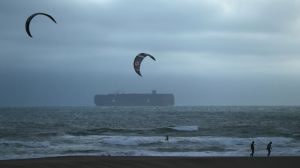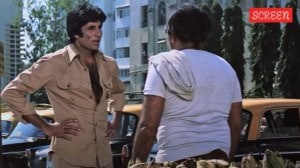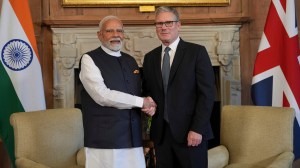From scrapyard to statues: Behind Ahmedabad’s new installations
The first installation done in February this year was near Subhash Bridge — the only conceptual art work. Coloured in green, it shows 20 hands holding the flags of each of the G20 countries on their cuffs.
 (Left) Newly installed statues at Pakwan Circle in Bodakdev and near Airport Circle (Right) in Ahmedabad. (Express Photo by Nirmal Harindran)
(Left) Newly installed statues at Pakwan Circle in Bodakdev and near Airport Circle (Right) in Ahmedabad. (Express Photo by Nirmal Harindran) Discarded water pipelines from the Narmada main canal, electric street poles, chlorine tanks from sewage treatment plants, railway tracks, electric cable rolls — these are the wastes that have gone into the beautification of Ahmedabad city.
Conceptualised by Surat-based sculpture artist Sunil Sridhar, nearly 70 tonne waste — most of it iron and steel — have gone into the making of 10 statues recently placed at nine prominent locations, mostly crossroads, of the city. Predominantly focused on the simplicity of public interaction with the statues, the artwork also has a connection with the city and locals.
The urban beautification project of Ahmedabad city was conceived around six months ago keeping in mind the ongoing G20 presidency events, said Ahmedabad Municipal Corporation Joint Director (mechanical) Vijay Mistry.
According to Mistry, the standing committee cleared the project to install the statues made out of scrap at an estimated Rs 1 crore. Sources revealed that the 10 installations are a part of the first phase and the second phase is expected to follow soon. The second phase is likely to have mid-sized and larger statues.
Among the statues installed is that of a horse taking a leap that has been installed at Indira Bridge, a bull at CG Road — a commercial centre, Mahatma Gandhi statue at the Airport Circle, and one themed on Uttarayan near Kankaria Lake Gate Number 1 that has boys wearing glasses and blowing a horn. Another statue, titled teniya (toddler), is that of a boy holding a kite to be released at Usmanpura Crossroads. The Commerce Six Road, the address to several educational institutes, has the sculpture of a head, while the Pakwan Crossroad has bird — hornbill and pelican — statues.
“The toughest among the nine themes was the pair of flowers that had been installed on the Expressway, one on either side welcoming and thanking visitors to the city,” Sridhar said.
“With a size of 25 by 6 by 14 feet, the 16 mm wide and 10 mm thick steel scrap reinforced using railway tracks moulding such material to show fluidity and curves of a flower to indicate its gentleness and softness was not easy. Also, the most delicate-looking sculptures, both combined, are the heaviest among all statues. Both the flowers weigh 15 tonnes,” Sridhar says. The bull weighs 3 tonnes, while the horse weighs eight tonnes.
The 56-year-old artist moved to Surat from Ahmedabad in the late 1990s, while the rest of his family settled abroad. Sridhar has to his credit 23 sculptures in Pune and 72 in Surat. He was also among the team that worked at the National Salt Satyagraha Memorial in Dandi.
“This is the third statue of Mahatma Gandhi I have created — the other two are at the Dandi memorial. I wanted to visually depict his pace and power. Being a lean body, I thought of him taking a big leap depicting force,” shares the sculptor.
The first installation done in February this year was near Subhash Bridge — the only conceptual art work. Coloured in green, it shows 20 hands holding the flags of each of the G20 countries on their cuffs. “While to some it gives an impression of a turban, to others it is a boat. It is open to interpretation,” the artist says.
The remaining statues are figurative. In order to give longevity to the sculptures, the material has been treated, including short blasted by copper slack or copper flux — a residue left behind while purifying copper. While this makes the metal look like new, epoxy-based primer and polyurethane-based paint has been used for a longer life. “These statues installed permanently at these locations are expected to last for at least 30 years,” says Mistry. However, he claims these statues will sustain the weather for not less than 50 years because of the treated material.











